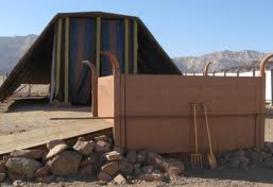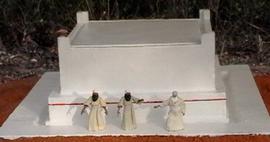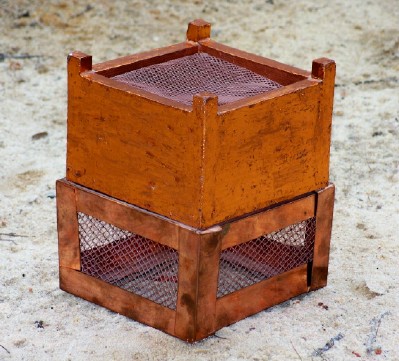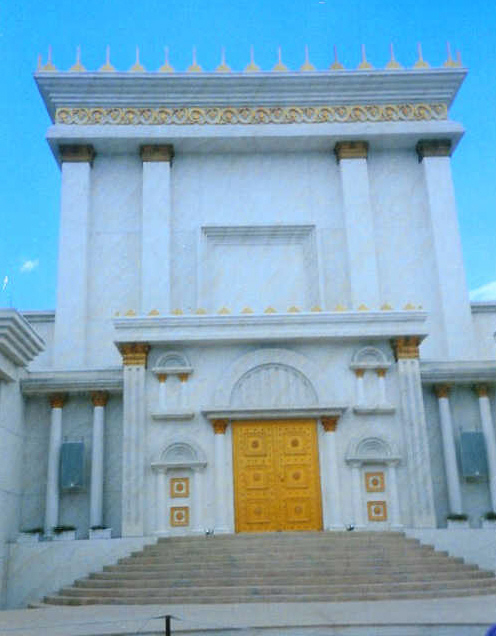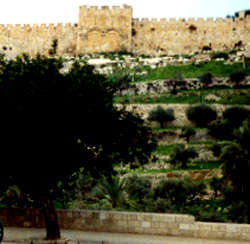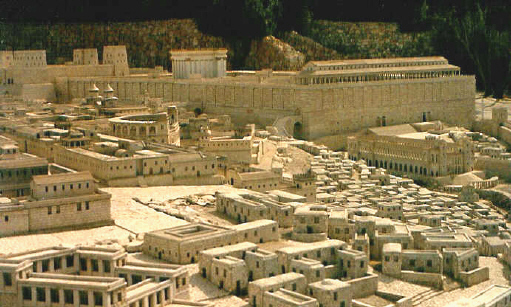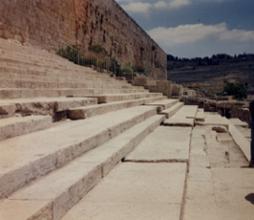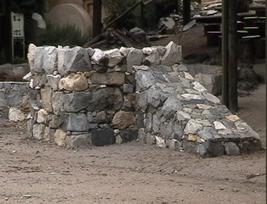"So That I May Dwell Among Them"
When Adam and Eve were still in the Garden of Eden, Elohim used to walk among them. (Gen. 3:8) They had open, direct fellowship with the Creator. But things changed one dark day when they broke that relationship. The Garden’s eastern entrance was closed off. Entering YHWH's presence was no longer a simple matter.
But He promised to one day bring about a "restoration of all things." (Acts 3:9)
He began by calling Abraham out from his own people--the first step in delineating a holiness that was needed to form a solid foundation for this reconstruction. When Abraham's descendants had formed a big enough community to inherit a land He likewise marked off as holy, they were brought out of Egypt and told:
"YHWH your Elohim walks in the midst of your camp... So your camp must be holy, so that He will see nothing unclean in you, and turn away from backing you."
(Deut. 23:14)
The Tabernacle
This holiness took the form of particular standards that He laid out in the Torah of Moses:
"If you walk in My instructions, guard My commands and carry them out... I will set My dwelling place in your midst, ...walk among you, and be your Elohim..."
(Lev. 26:3, 11-12)
If His people would follow these instructions, their lives would be "like the days of heaven on the earth" (Deut. 11:21) --i.e., like a return to Eden! A special dwelling was to symbolize His presence:
"Tell the descendants of Israel to ... prepare a set-apart place for Me, so that I may dwell among them. Make it exactly according to the pattern that I am showing you." (Exodus 25:2, 8-9)
He added that once the promised Land was settled, He would choose a place for it where He would "set His name" (Deut. 12:5-26, etc.).
The Temple
The Gihon Spring is Jerusalem’s only natural water source. But it was also one of the rivers that flowed from the Garden of Eden. So there is a special connection between Jerusalem and Eden. YHWH left a small remnant of the "living water" (which is what can symbolically cleanse what is defiled) from the Garden accessible to those who would pick up the cue.
King David recognized that this was the Place where YHWH had chosen to set His Name. (2 Kings 21:7; 2 Chron. 6:20) He claimed the city for Israel, and his descendant/successor Hizqiyahu (Hezekiah) fortified it, channeling the Gihon inside the city walls as a water source to enable the city to ride out a siege that did come in his own day. This is a picture of what David had learned to do: "Your word have I hidden in my heart so that I might not sin against You." (Psalm 119:11)
"The Place Where I have Set My Name"
Here is one aspect of this promise to Moses of where the Temple would be established: the valleys around Jerusalem form the Hebrew letter "Shiin",
which is often used as an abbreviation for one of YHWH's names, "Shaddai",
such as on a doorpost mezuzzah (example shown at right).
So David had his son Solomon build a more permanent dwelling right there. It was much more elaborate, but the basic layout was the same as the Tabernacle.
Yet the "camp" in which YHWH walked split into two shortly thereafter. The Temple still stood, but the unified dwelling place for YHWH that it represented was no longer intact. The larger Northern kingdom, which retained the name "the House of Israel", slid quickly into idolatry and Gentile ways, and was therefore scattered among all nations, essentially becoming Gentiles themselves. The other half, Judah, followed suit more slowly but at last lost the Temple. But when they repented, YHWH allowed it to be rebuilt. Yet the other half of the covenant people was still missing. Isaiah 49:6 tells us that one of the main reasons Messiah would come was to regather them, since YHWH had not lost track of who they were, and had preserved them nonetheless.
If you have responded to His message, you are probably one of them!
The Way Back In
Curiously, YHWH told the prophet Ezekiel that the Northern Kingdom’s ticket to full restoration to citizenship would be our response to the Temple's layout:
“Son of man, the House of Israel will no longer defile the place of My throne, and the place of the soles of My feet, or My holy Name... When they remove their prostitution and their kings' idols far from Me, I will dwell in their midst forever. You, son of man, confront the House of Israel with the Temple, so that they may be ashamed of their iniquities, then let them measure the pattern." (Ezekiel 43:7-10)
In the Messiah's day, a fence (called the soreg) prohibited non-Jews from entering the inner Temple courts. This was understandable since the Greeks had defiled the altar, as we remember at Hanukkah. But keeping all Gentiles out oversimplified the distinctions YHWH had set up, and this law added by men was unwittingly screening out those who were returning from the Northern Kingdom. Isaiah (26:2) tells Judah to open the gates that the righteous nation might enter in, and even the rabbinic writers believe that this refers to the return of the lost tribes. So this is the wall that Paul said Yeshua had figuratively broken down. (Eph. 2:14) It is significant that the apostles, who were well aware that YHWH was restoring the lost tribes, did most of their teaching right in the Temple courts, where so many object lessons were right at hand.
The Eastern Gate (pictured at left), once the most direct route into the Temple, is now closed off, just like the eastern gate to Eden. But there was another, roundabout way in. Before one could even enter the Temple compound, he or she had to go through a total immersion in order to come into the Temple in a state of ritual purity. This represents repentance and the fresh start it allows.
Then there were 32 steps to ascend to the first gates. (We mustn't stop on the first for very long if we want all that YHWH has for us.) Next, worshippers had to walk up a long tunnel and across a wide courtyard just to get to the entrance to the Temple complex proper. So there was a long way to go just to get back to what used to be the starting point! Likewise, access to Eden can be regained, but only through repentance and the long process of unlearning our fleshly ways and relearning the right patterns of walking as outlined and exemplified in His Torah (instruction).
The altar then stood between us and the Temple doors, reminding us that we need blood atonement before we can enter YHWH’s presence. Animals were the picture, but they could never fully cover human sin, but we had to await a human being who was truly without spot or blemish before the picture could be transferred to the reality. Through Yeshua’s blood, we can be restored to the same footing Adam had before he fell, and with even more advantages. But only then can we begin to worship as we were really meant to.
Some of the Temple’s chief gates were only open on the Sabbath and Festivals, showing us how important those days are to understanding the proper way to approach YHWH. Through the manna, He used the Sabbath as a test of Israel’s obedience even before the Torah was given, so you can imagine how important the Sabbath is in His screening out who can move to a higher level in their drawing near to Him. (See Isaiah 56:4-8.) And “drawing near” is really what the Hebrew term for "sacrifice" or "offering" (qorban) means.
The whole Temple complex pictures a series of ascents into higher degrees of holiness. Every aspect of its architecture and furniture teaches us how to prepare ourselves to enter YHWH’s presence.
Another Temple
In the Torah, Yahweh had specified that a house with "leprosy" had to have the affected stones removed, and if it kept spreading, the whole house had to be taken down. (Lev. 14:34ff) As Yeshua prophesied, due to Judah's rejecting the open door for repentance and restoration that he brought, not one stone of the Temple was left on top of another. (Matithyahu 24:2)
But He gave other prophecies that require there to be a Temple in place once again, Also, the Temple as Ezekiel describes it has never yet been built, so at least some kinds of qorban will once again be offered in Jerusalem.
This does not contradict the finished work of Messiah; the blood of bulls and goats never did take away sin. (Hebrews 10:4) We do have the more effective sacrifice in Yeshua’s death, because his successful resistance to temptation undid the first Adam's failure. But during his Kingdom, there will still be many people who know nothing about him to teach about all the nuances of what his redemption entails, and that’s what the offerings always were for. People from every nation on earth will be required to come up to Jerusalem for the Feast of Sukkoth, a festival that mandates the sacrifice of 70 bulls and other animals. (Zech. 14:18-19) Also, many of the offerings have nothing to do with sin, but are voluntary expressions of just wanting to draw closer to YHWH.
The actual implements for use in the next Temple are already being prepared. This is an exciting development to which we'd do well to pay attention. Ultimately, though, it is far more important to have a spiritual temple than a physical one.
"Your body is the Temple of the Spirit of Holiness." (1 Cor. 6:19) That demands holiness in our hearts as well as our conduct. But our individual temples are only a microcosm of something larger. The Messiah is called the cornerstone of a permanent Temple that will include both Jews and former Gentiles whom he has brought near and made part of Israel. (Psalm 118:22; Isa. 28:16; Ephesians 2:13-22)
Becoming His Dwelling Place
"You, as living stones, are being built into a spiritual house...to offer up spiritual 'slaughter offerings' acceptable to Elohim." (1 Peter 2:5; cf. 2 Cor. 6:16)
The main point of the physical Temple is indeed to teach us what the community in which YHWH can make His home is meant to look like.
Some people got the point. Ancient synagogues were designed to have congregants face each other like the cherubim atop the Ark of the Covenant, which in the process of looking at one another were said to also be looking at the place He would meet with us. (Exodus 25:20, 22) The fruit of a renewed obedience to His Torah, when we understand its underlying spirit, will be to love one another, unselfishly using our gifts to repair the breached walls. And the most tangible way to express our love for Him is to show love to one another.
The altar was built from uncut stones, shaped only by water--a symbol of having our doctrines formed by the direct influence of Yahweh’s Word, rather than being conformed to human purposes. The Temple itself was built with chiselled stones, to which man had set his hand, symbolizing those whose doctrines have been muddied by human theologies, but who will still be in the Kingdom because they have at least responded to Yeshua. Yet he himself said those who disregard any of the commandments will be least in this Kingdom. We make the choice of which we will be. (2 Tim. 2:20ff; 1 Cor. 3:11ff)
Historically, every time the tabernacle or temple came into use, the altar was built first. YHWH is calling out a corps of forerunners who will not be satisfied to climb only the first step of salvation, but will press on to be as holy as they can possibly be, getting up all 32 steps to His heart (for "heart" has the numerical value of 32 in Hebrew).
But uncut stones don't stay together easily. What can hold together the many different shapes of stones that are so very different but who each fill a very necessary place in His "building"? It is the love we have for one another. Rather than trying to make the other stones look just like us, Paul told us to
"eagerly pursue the kinds of things that promote peace, and the things that facilitate the building process in which we fit into one another." (Romans 14:19)
Once that is constructed (1 Corinthians 3:9-17), then His dwelling place will be complete:
"I saw the set-apart city, the renewed Jerusalem, coming down out of heaven, adorned as a Bride for her Husband, and I heard a loud voice from the heavens, saying, 'Look! The dwelling place of Elohim is with men, and He will dwell with them, and they will be His people...'" (Rev. 21:2-3)
This will finally be the "days of heaven on earth", not just metaphorically but in reality, and the actual return to Eden!
Tabernacle model in Merritt Island, Florida
Model in Orlando, Florida
From a book by Arthur Custance
Model in Jerusalem, Israel

